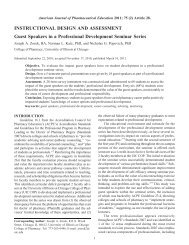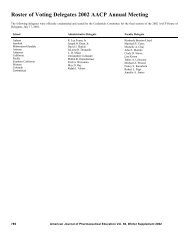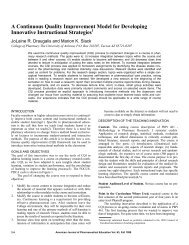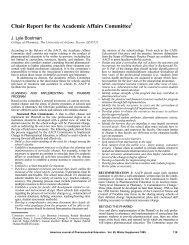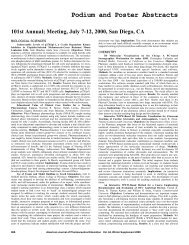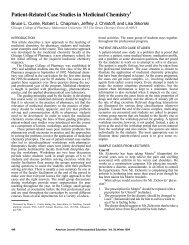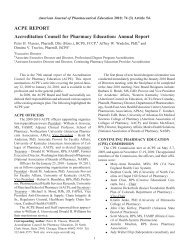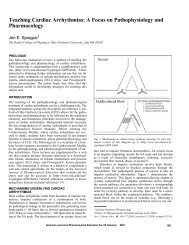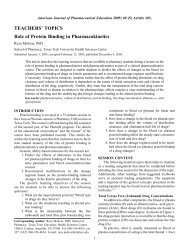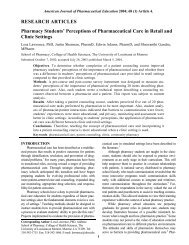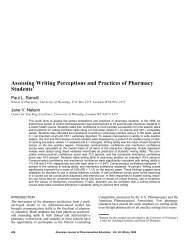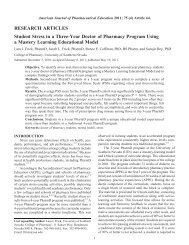RESEARCH ARTICLES Pharmacy Students' Attitudes Toward a ...
RESEARCH ARTICLES Pharmacy Students' Attitudes Toward a ...
RESEARCH ARTICLES Pharmacy Students' Attitudes Toward a ...
Create successful ePaper yourself
Turn your PDF publications into a flip-book with our unique Google optimized e-Paper software.
American Journal of Pharmaceutical Education 2009; 73 (7) Article 134.<br />
workload. 4 Also, many of the public health activities are<br />
considered as secondary activities that are provided only<br />
when resources (people, time, and money) allow since<br />
they do not produce revenue.<br />
Given their relatively recent recognition as providers<br />
of preventative services, 5-7 pharmacists, like other healthcare<br />
professionals, will now be expected to play an active<br />
role in the public health arena. Accordingly, training<br />
pharmacists as public health providers will need to become<br />
a central part of their curriculum. Traditionally,<br />
little course work was devoted to public health. To address<br />
this gap and develop student competencies in the<br />
area of public health prevention services and health promotion,<br />
the American Association of College of <strong>Pharmacy</strong><br />
(AACP) released the Social and Administrative<br />
Sciences (SAS) Supplemental Educational Outcomes in<br />
2007. 8 These outcomes recognize the need for pharmacists<br />
to provide public health programs that take into account<br />
risk factors and pharmacoepidemiologic data and<br />
challenge practitioners to ‘‘assure that all relevant members<br />
of a patient population receive needed services.’’<br />
Concepts related to public health have been integrated<br />
into the curriculum of some pharmacy colleges. 9 Such<br />
a curriculum should provide pharmacy students with the<br />
competencies required to integrate public health principles<br />
in their practice after graduation.<br />
A central question while integrating public healthrelated<br />
concepts in the curriculum is whether public<br />
health concepts should be incorporated into an existing<br />
course, taught as an independent required course, or offered<br />
as an elective course. Much of the literature on<br />
public health in pharmacy has focused on students’ attitudes<br />
toward and experiences in service-learning projects<br />
in a course that was offered either as an elective or<br />
a pharmacy practice experience. While pharmacy students<br />
have responded positively toward elective and experiential<br />
public health courses, their perceptions<br />
regarding a required public health course have not been<br />
reported/studied previously.<br />
In order to successfully develop a curriculum that<br />
meets the goals outlined in the SAS Outcomes, the attitudes<br />
and values of pharmacy students regarding public<br />
health must be assessed. While there is abundant literature<br />
on nursing students’ and medical students’ attitudes towards<br />
public health and health promotion, 10-13 the literature<br />
on pharmacy students’ attitudes towards public<br />
health is sparse. This study assessed pharmacy students’<br />
attitudes towards a required public health course, as well<br />
as their attitudes towards developing a public health program.<br />
The findings provide insight into student enthusiasm,<br />
in general, towards learning public health-related<br />
principles as an integral part of the curriculum.<br />
2<br />
The main objective of this study was to explore pharmacy<br />
students’ attitudes toward a required public health<br />
course and assess their attitudes toward developing a public<br />
health program. A secondary objective was to test the<br />
psychometric properties of the scales used in the study.<br />
METHODS<br />
Public Health in <strong>Pharmacy</strong> is a required first-year<br />
course in the doctor of pharmacy (PharmD) program at<br />
the Arnold and Marie Schwartz College of <strong>Pharmacy</strong> The<br />
course was developed in 2006 by faculty members in the<br />
Social Administrative Sciences and <strong>Pharmacy</strong> Practice<br />
divisions at the college using public health-related concepts<br />
outlined in Clinical Prevention and Population<br />
Health Framework for Health Professions, a publication<br />
developed by the Healthy People Curriculum Task<br />
Force 14 and based on the endpoints outlined in the AACP<br />
Supplemental outcomes for SAS. 8 The course was consequently<br />
approved by the curriculum committee at the college<br />
in 2006. The content areas covered in the lecture<br />
portion of the course (3 hours each week) consisted of:<br />
(1) introduction to public health: what is public health,<br />
history of public health and pharmacist role in public<br />
health, definitions widely used in public health, healthy<br />
people 2010 goals; (2) evidence-based practice: epidemiology<br />
and biostatistics, methods for evaluating health research<br />
literature, outcome measures, determinants of<br />
health, and health surveillance; (3) health promotion: program<br />
development principles using the precede-proceed<br />
model with an emphasis on cultural competence and eliminating<br />
health disparities; (4) health systems and health<br />
policy: organization and financing of public health activities;<br />
and (5) community aspects of practice: pharmacist<br />
role in emergency preparedness such as bioterrorism, immunizations,<br />
chronic disease management and prevention<br />
services, environmental and occupational health,<br />
and international health issues.<br />
During the recitation portion of the course (1 hour<br />
each week), students were assigned an ethnicity (non-<br />
Hispanic whites, African-Americans, Asians, and<br />
Hispanics) on which they worked individually and collaboratively<br />
in groups to (1) design a health promotion<br />
and disease prevention program, and (2) present and explain<br />
the program to the recitation section and faculty<br />
members. Students were provided with a series of community<br />
needs assessments forms designed by the authors<br />
based on the precede-proceed model, 15 which was taught<br />
in an earlier course (Behavior and Ethics in <strong>Pharmacy</strong>),<br />
and emphasized as an important model for developing<br />
public health programs. The needs assessment form was<br />
completed by each student as a homework assignment and<br />
used by each group to identify and explore the health



